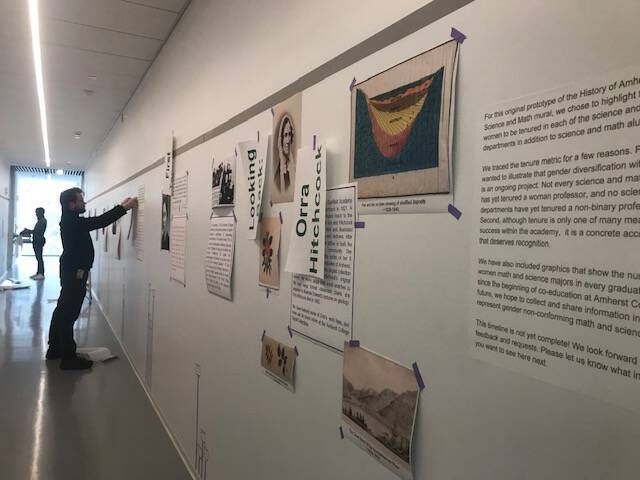Science Center Features Amherst History of Women in STEM

Past the café, down in the teaching lab area on the first floor, stands a white-washed hallway in the Science Center. To Jess Martin, the administrative director of the Science Center, and her team — Michaela Ednie ’18, HSTEM and Science Center Curation Assistant, and Ana Battaglino ’21 — this blank space was an opportunity. In collaboration with the Association for Women in Science at Amherst, they saw it as an opportunity to create a living, breathing display that showcases women in Science, Technology, Engineering and Math (STEM). A display that works to humanize the new, shiny Science Center as it seeks to truly become part of the college community.
The new mural presents a timeline outlining the history of women in science and math at the college. This display also depicts female faculty in STEM who have been tenured — many of whom are still currently at Amherst. It reveals how much of the history depicted is still in the making. The mural wields the ability to draw in the voices of the college community through its display of photographs. The display encourages female students in science and math majors to post photographs of themselves on the wall. Photobooth hours are available at least once a week — times are posted next to the mural — and students can even send their headshots to Ednie so that she can post them.
The length of the timeline is fairly short, since Amherst only began hiring female tenure-track professors in 1962 and admitting female students in 1975, but its impact remains significant. Not only did Martin and her team begin building this timeline during women’s history month, but it comes during a pivotal moment in the college’s history. Last year’s graduating class had the highest number of women in STEM majors to date — reaching a high of 99 women in the graduating class, according to institutional research by Jesse Barba. This year, the college is on track to break three digits. Martin hopes to attend to the ever-changing nature of the college through what she calls “living displays.” She aims to make the walls and the space of the Science Center vibrant, alive and dynamic. She describes that stationary displays often begin to blend into the background. Martin and her team attempt to fight this by putting displays in places where they’re most unexpected, like in a hidden hallway on the way to the bathroom. The timeline demands interaction and attention, with moveable displays and photos.
This mural is a part of a larger project at Amherst called Inspire Science. Inspire Science seeks to mesh the themes of curiosity, empirical evidence, observation and inference, science laws and theories, objectivity and subjectivity, scientific method and creativity. All of these themes will have a corresponding station around the Science Center. The observation and inference station aligns with the women in STEM timeline. Martin and her team see this as a way to make individuals indirectly aware of these prevailing scientific themes as they appear and relate to all aspects of life. Through the use of the themes, the Science Center opens up other facets of learning and exploration. This project seeks to give a physical form to these abstract concepts. Through this project, creativity and curiosity can make the Science Center an open and welcoming place for all students, not just those in science.





Comments ()